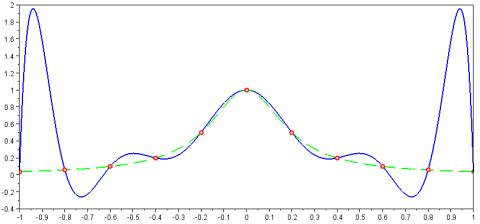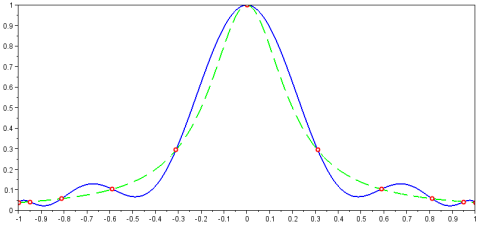Lagrange polynomial interpolation
This article was kindly contributed by Vlad Gladkikh
—
Assume we have data (xi, yi), i = 1, …, n.
The data don’t have to be equally spaced.
We can pass a Lagrange polynomial P(x) of degree n−1 through these data points.
function y = lagrange_interp(x,data)
for i = 1:length(x)
y(i) = P(x(i),data);
end
endfunction
The polynomial P(x) is a linear combination of polynomials Li(x), where each Li(x) is of degree n−1
P(x) = y1L1(x) + y2L2(x) + … + ynLn(x)
The polynomials Li(x) are defined as
Li(x) = (x−x1) … (x−xi-1)(x−xi+1) … (x−xn) / αi
where
αi = (xi−x1) … (xi−xi-1)(xi−xi+1) … (xi−xn)
It is obvious that Li(xj) = δij and therefore P(xi) = yi meaning that the polynomial P passes through all the data (xi, yi), i = 1, …, n.
If the the data (xi, yi) are organized in an n×2 matrix, then the polynomial P can be computed as follows
function y = P(x,data)
n = size(data,1);
xi = data(:,1);
yi = data(:,2);
L = cprod_e(xi,x) ./ cprod_i(xi);
y = yi' * L;
endfunction
where the function cprod_e calculates the numerators of Li(x) for each i, namely all the products
(x−x1) … (x−xi-1)(x−xi+1) … (x−xn)
function y = cprod_e(x,a)
n = length(x);
y(1) = prod(a-x(2:$));
for i = 2:n-1
y(i) = prod(a-x(1:i-1))*prod(a-x(i+1:$));
end
y(n) = prod(a-x(1:$-1));
endfunction
The function cprod_i calculates all αi for i = 1, …, n.
function y=cprod_i(x)
n = length(x);
y(1) = prod(x(1)-x(2:$));
for i = 2:n-1
y(i) = prod(x(i)-x(1:i-1))*prod(x(i)-x(i+1:$));
end
y(n) = prod(x(n)-x(1:$-1));
endfunction
Now, let’s test our code.
I take two examples from the book “Fundamentals of Engineering Numerical Analysis” by Prof. Parviz Moin.
Both examples use data obtained from the Runge’s function
y = 1/(1+25 x2)
The data in the first example are equally spaced:
data1=[... -1.0 0.038; -0.8 0.058; -0.6 0.1; -0.4 0.2; -0.2 0.5; 0.0 1.0; 0.2 0.5; 0.4 0.2; 0.6 0.1; 0.8 0.058; 1.0 0.038];
The commands to perform Lagrange interpolation are:
x = linspace(-1,1,1000); y = lagrange_interp(x,data1);
Here’s the plot of the data (red circles), the Lagrange polynomial (solid line) and the Runge’s function (dashed line):
plot(x,y,'-b',... x, 1.0 ./ (1+25.*x.^2),'--g',... data1(:,1),data1(:,2),'or')
The second example takes non-equally spaced data:
data2 = [... -1.0 0.038; -0.95 0.042; -0.81 0.058; -0.59 0.104; -0.31 0.295; 0.0 1.0; 0.31 0.295; 0.59 0.104; 0.81 0.058; 0.95 0.042; 1.0 0.038];
Interpolating and plotting them as we did in the previous example produces the following picture.
y = lagrange_interp(x,data2); plot(x,y,'-b',... x, 1.0 ./ (1+25.*x.^2),'--g',... data2(:,1),data2(:,2),'or')

